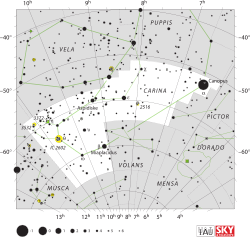Iota Carinae

| |
| Observation data Epoch J2000 Equinox J2000 | |
|---|---|
| Constellation | Carina |
| Right ascension | 09h 17m 05.40686s[1] |
| Declination | −59° 16′ 30.8353″[1] |
| Apparent magnitude (V) | 2.21[2] |
| Characteristics | |
| Spectral type | A9 Ib[3] |
| U−B color index | +0.16[4] |
| B−V color index | +0.18[4] |
| Variable type | Suspected[5] |
| Astrometry | |
| Radial velocity (Rv) | 13.3[2] km/s |
| Proper motion (μ) | RA: –19.03[1] mas/yr Dec.: +13.11[1] mas/yr |
| Parallax (π) | 4.71 ± 0.46[1] mas |
| Distance | 690 ± 70 ly (210 ± 20 pc) |
| Details | |
| Mass | 7.4[6] M☉ |
| Luminosity | 4,900[6] L☉ |
| Surface gravity (log g) | 2.40[6] cgs |
| Temperature | 7,500[6] K |
| Metallicity [Fe/H] | –0.14[6] dex |
| Rotational velocity (v sin i) | 10.0[6] km/s |
| Age | 37.4 ± 5.1[7] Myr |
| Other designations | |
Iota Carinae (ι Car, ι Carinae) is a star in the southern circumpolar constellation of Carina. With an apparent visual magnitude of 2.2,[2] it is one of the brighter stars in the night sky. It can be seen from the latitude of Alexandria or Mobile, Alabama and southward.[9] This star has the traditional name Aspidiske, which should not be confused with Asmidiske, the proper name of ξ Puppis. Due to precession of the Earth's axis of rotation, Iota Carinae will be the South Star around 8100 CE.
Properties
Based on parallax measurements, this star is located at a distance of about 690 light-years (210 parsecs) from the Earth. It has a stellar classification of A9 Ib,[3] with the luminosity class of 'Ib' indicating it has reached the stage of its evolution where it has expanded to become a lower luminosity supergiant star.
Iota Carinae has more than seven times the Sun's mass[6] and has expanded to roughly 43 times the Sun's radius.[10] It is radiating about 4,900 times the luminosity of the Sun.[6] However, this luminosity appears to vary, causing the star's apparent magnitude to range between 2.23–2.28.[5] This energy is being radiated into space from the star's outer envelope at an effective temperature of 7,500 K,[6] giving Iota Carinae the white hue typical of an A-type star.[11]
Etymology
It has the traditional names Aspidiske, Scutulum and Turais (or Tureis, a name shared with Rho Puppis). Turais is from the Arabic تُرَيْس turais "shield" (diminutive), while Aspidiske and Scutulum are the Greek and Latin translations, the diminutives of ασπίδα and scūtum "shield".[9]
In Chinese, 海石 (Hǎi Dàn), meaning Sea Rock, refers to an asterism consisting of ι Carinae, ε Carinae, HD 83183, HD 84810 and υ Carinae .[12] Consequently, ι Carinae itself is known as 海石二 (Hǎi Dàn èr, English: the Second Star of Sea Rock).[13]
References
- ↑ 1.0 1.1 1.2 1.3 1.4 van Leeuwen, F. (November 2007), "Validation of the new Hipparcos reduction", Astronomy and Astrophysics 474 (2): 653–664, arXiv:0708.1752, Bibcode:2007A&A...474..653V, doi:10.1051/0004-6361:20078357
- ↑ 2.0 2.1 2.2 Wielen, R. et al. (1999), Sixth Catalogue of Fundamental Stars (FK6). Part I. Basic fundamental stars with direct solutions (35), Astronomisches Rechen-Institut Heidelberg, Bibcode:1999VeARI..35....1W
- ↑ 3.0 3.1 Houk, Nancy (1978), Michigan catalogue of two-dimensional spectral types for the HD stars 1, Ann Arbor: Dept. of Astronomy, University of Michigan, Bibcode:1975mcts.book.....H
- ↑ 4.0 4.1 Johnson, H. L. et al. (1966). "UBVRIJKL photometry of the bright stars". Communications of the Lunar and Planetary Laboratory 4 (99). Bibcode:1966CoLPL...4...99J.
- ↑ 5.0 5.1 Ruban, E. V. et al. (September 2006), "Spectrophotometric observations of variable stars", Astronomy Letters 32 (9): 604–607, Bibcode:2006AstL...32..604R, doi:10.1134/S1063773706090052
- ↑ 6.0 6.1 6.2 6.3 6.4 6.5 6.6 6.7 6.8 Smiljanic, R. et al. (April 2006), "CNO in evolved intermediate mass stars", Astronomy and Astrophysics 449 (2): 655–671, arXiv:astro-ph/0511329, Bibcode:2006A&A...449..655S, doi:10.1051/0004-6361:20054377
- ↑ Tetzlaff, N.; Neuhäuser, R.; Hohle, M. M. (January 2011), "A catalogue of young runaway Hipparcos stars within 3 kpc from the Sun", Monthly Notices of the Royal Astronomical Society 410 (1): 190–200, arXiv:1007.4883, Bibcode:2011MNRAS.410..190T, doi:10.1111/j.1365-2966.2010.17434.x
- ↑ "iot Car -- Variable Star", SIMBAD (Centre de Données astronomiques de Strasbourg), retrieved 2012-01-14
- ↑ 9.0 9.1 Allen, Richard Hinckley (1899), Star-names and their meanings, G. E. Stechert, p. 74
- ↑ Kaler, James B., "ASPIDISKE (Iota Carinae)", Stars (University of Illinois), retrieved 2012-01-14
- ↑ "The Colour of Stars", Australia Telescope, Outreach and Education (Commonwealth Scientific and Industrial Research Organisation), December 21, 2004, retrieved 2012-01-16
- ↑ (Chinese) 中國星座神話, written by 陳久金. Published by 台灣書房出版有限公司, 2005, ISBN 978-986-7332-25-7.
- ↑ (Chinese) 香港太空館 - 研究資源 - 亮星中英對照表, Hong Kong Space Museum. Accessed on line November 23, 2010.
| ||||||||||||||||||||||||||||||||||||||||||||||||||||||||||||||||||||||||||||||